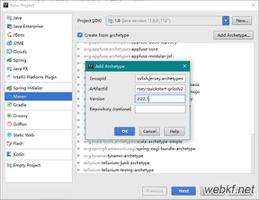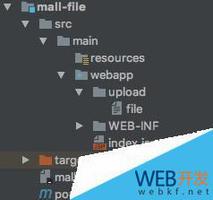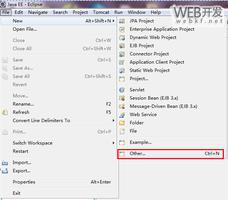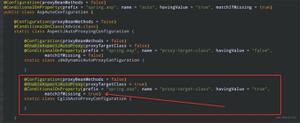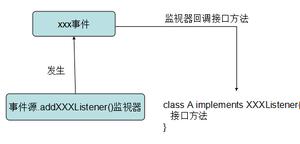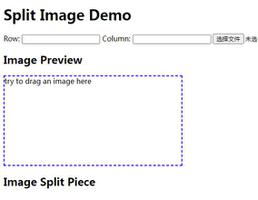Java文件上传以及Jersey静态Web服务中的其他对象
我想通过上传图像和员工数据来在系统中创建员工信息。我可以使用球衣使用其他休息电话来做到这一点。但我想在一个电话会议中实现。我在下面提供结构。请帮我在这方面怎么做。
@POST@Path("/upload2")
@Consumes({MediaType.MULTIPART_FORM_DATA,MediaType.APPLICATION_XML, MediaType.APPLICATION_JSON})
public Response uploadFileWithData(
@FormDataParam("file") InputStream fileInputStream,
@FormDataParam("file") FormDataContentDisposition contentDispositionHeader,
Employee emp) {
//..... business login
}
每当我尝试执行此操作时,Chrome邮递员都会出现错误。我的Employee json的简单结构如下。
{ "Name": "John",
"Age": 23,
"Email": "john@gmail.com",
"Adrs": {
"DoorNo": "12-A",
"Street": "Street-11",
"City": "Bangalore",
"Country": "Karnataka"
}
}
但是,我可以通过拨打两个不同的电话来做到这一点,但我想在一个休息电话中实现,这样我就可以接收文件以及员工的实际数据。
请你在这方面提供帮助。
回答:
你不能有两个Content-Types(从技术上讲,这是我们在下面执行的操作,但是它们与multipart的每个部分都分开,但是主要类型是multipart)。这基本上就是你对方法的期望。你期望mutlipart 和 json一起作为主要媒体类型。该Employee数据需要多部分的一部分。所以,你可以添加@FormDataParam("emp")的Employee。
@FormDataParam("emp") Employee emp) { ...这是我用来测试的课程
@Path("/multipart")public class MultipartResource {
@POST
@Path("/upload2")
@Consumes({MediaType.MULTIPART_FORM_DATA})
public Response uploadFileWithData(
@FormDataParam("file") InputStream fileInputStream,
@FormDataParam("file") FormDataContentDisposition cdh,
@FormDataParam("emp") Employee emp) throws Exception{
Image img = ImageIO.read(fileInputStream);
JOptionPane.showMessageDialog(null, new JLabel(new ImageIcon(img)));
System.out.println(cdh.getName());
System.out.println(emp);
return Response.ok("Cool Tools!").build();
}
}
首先,我刚刚使用客户端API进行了测试,以确保它可以正常工作
@Testpublic void testGetIt() throws Exception {
final Client client = ClientBuilder.newBuilder()
.register(MultiPartFeature.class)
.build();
WebTarget t = client.target(Main.BASE_URI).path("multipart").path("upload2");
FileDataBodyPart filePart = new FileDataBodyPart("file",
new File("stackoverflow.png"));
// UPDATE: just tested again, and the below code is not needed.
// It's redundant. Using the FileDataBodyPart already sets the
// Content-Disposition information
filePart.setContentDisposition(
FormDataContentDisposition.name("file")
.fileName("stackoverflow.png").build());
String empPartJson
= "{"
+ " \"id\": 1234,"
+ " \"name\": \"Peeskillet\""
+ "}";
MultiPart multipartEntity = new FormDataMultiPart()
.field("emp", empPartJson, MediaType.APPLICATION_JSON_TYPE)
.bodyPart(filePart);
Response response = t.request().post(
Entity.entity(multipartEntity, multipartEntity.getMediaType()));
System.out.println(response.getStatus());
System.out.println(response.readEntity(String.class));
response.close();
}
我刚刚创建了一个简单的Employee类,id并带有and name字段进行测试。这工作得很好。它显示图像,打印内容配置,然后打印Employee对象。
我对Postman不太熟悉,所以我将测试保存到最后
如你所见,它似乎也可以正常工作”Cool Tools”。但是,如果我们查看打印的Employee数据,就会发现它为空。这很奇怪,因为使用客户端API可以正常工作。
如果我们查看“预览”窗口,就会发现问题所在
主体部分没有Content-Type标题emp。你可以在客户端API中看到我明确设置了它
MultiPart multipartEntity = new FormDataMultiPart() .field("emp", empPartJson, MediaType.APPLICATION_JSON_TYPE)
.bodyPart(filePart);
因此,我想这实际上只是完整答案的一部分。就像我说的,我对邮递员不熟悉,所以我不知道如何Content-Type为身体的各个部位设置s。在image/png对图像进行自动为我设置的图像部分(我猜它只是由文件扩展名确定)。如果你能解决这个问题,那么应该解决问题。请,如果你知道如何执行此操作,请将其发布为答案。
请参阅此处以了解更多有关MultiPart with Jersey的信息。
基本配置:
依赖关系:
<dependency> <groupId>org.glassfish.jersey.media</groupId>
<artifactId>jersey-media-multipart</artifactId>
<version>${jersey2.version}</version>
</dependency>
客户端配置:
final Client client = ClientBuilder.newBuilder() .register(MultiPartFeature.class)
.build();
服务器配置:
// Create JAX-RS application.final Application application = new ResourceConfig()
.packages("org.glassfish.jersey.examples.multipart")
.register(MultiPartFeature.class);
因此,从Postman客户端可以看到,某些客户端无法设置各个部分的Content-Type,包括浏览器,这是使用FormData(js)时的默认功能。
我们不能指望客户能找到解决办法,因此我们可以做的就是在接收数据时在反序列化之前显式设置Content-Type。例如
@POST@Path("upload2")
@Consumes(MediaType.MULTIPART_FORM_DATA)
public Response uploadFileAndJSON(@FormDataParam("emp") FormDataBodyPart jsonPart,
@FormDataParam("file") FormDataBodyPart bodyPart) {
jsonPart.setMediaType(MediaType.APPLICATION_JSON_TYPE);
Employee emp = jsonPart.getValueAs(Employee.class);
}
获取POJO会花费一些额外的工作,但是比强迫客户端尝试找到自己的解决方案要好。
如果你使用的连接器不同于默认的HttpUrlConnection,则你可能会对这些注释中的对话感兴趣。
以上是 Java文件上传以及Jersey静态Web服务中的其他对象 的全部内容, 来源链接: utcz.com/qa/397786.html

